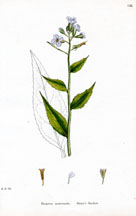Swarming Sweet Rocket
By Audrey Stallsmith

Nowadays the sweet rocket must look after itself in holes and corners on the edge of respectability.
Louise Beebe Wilder—The Fragrant Path
Like many other country folk, my father insists on calling sweet rocket “wild phlox.” I, on the other hand, persist in objecting to that inaccurate designation.
My argument has always been that phlox paniculata blooms in midsummer with the lilies, while hesperis matronalis appears in late spring with the irises and columbines. But another difference is that the summer blooming perennial boasts five petals, while the springtime biennial only has four.
So, while rocket isn’t phlox, it certainly is wild! Here in Pennsylvania, the plant persists on sowing itself with abandon in ditches, along the edges of woodlands, and wherever else it will remain undisturbed long enough to bloom.
But it was actually brought to the New World as a garden flower in the 1600’s before it escaped into the wild. And it still sows itself in my garden as vigorously as it does elsewhere. It’s more welcome than most invasives too, as it is pretty, sweet-smelling, and easy to yank when necessary.
The plant actually belongs to the mustard family, and has also been known as dame’s rocket, dame’s violet, night-scented gilliflower, eveweed, and vesper flower. Its name can be loosely translated as “mother of the evening,” probably in reference to the time of day it releases it scent—and to its prolific childbearing!
Although the leaves are sometimes employed as an acrid green in salads, in large amounts they can cause vomiting. The plant has also been used to prevent scurvy, to induce perspiration, or as a diuretic. It hosts such butterflies as the Orange Tip and Cabbage White, as well as many moths.
In the Language of Flowers hesperis represents “deceit,” since it scarcely has any fragrance at all during the day. But it is obviously just not a morning sort of plant! And it more than makes up for that lack with its heavily perfumed evening performance.
Image is from English Botany or Coloured Figures of British Plants, edited by John Boswell.








